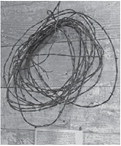Connections


At first glance, the bundle of rusted barbed wire hanging on a hook in the old barn doesn’t seem like something earth shattering.
After all, what impact could some wire fencing like you could find in any farm field have on the history of the United States. The answer to that question is a great deal.
The bundle of barbed wire in question was hanging in the barn at the Kuse Preserve in Medford and was part of a display of various farm implements including pick axes, scythes and forks which helped settlers in the region transform the rugged wilderness of north central Wisconsin into the sedate rolling farmland of today. I was at the preserve to take part in the 100th birthday celebration of Winnie the Pooh and to learn a little bit about being more mindful. This is something that the trails and open spaces of the Kuse Preserve are well suited for. As is often the case, I got sidetracked examining the rusted bits of history, only getting jostled out of my exploration by my son Alex who had come along with me on the exploration.
The first patent for barbed wire was issued in 1867 to Lucien Smith of Kent, Ohio. Others improved on his design and it was Joseph Glidden of DeKalb, Ill. who is credited with the modern invention which was patented in 1874.
Barbed wire is inexpensive to produce, easy to transport and even easier to erect, not requiring much in the way or special tools or labor compared to other, earlier forms of fencing.
Just as the steel plow opened the prairies for farming, barbed wire allowed farmers and ranchers to easily contain much larger herds of livestock. There is a direct link between the development of barbed wire and the fast food burger you gulped down at lunch this afternoon.
Barbed wire did a good job in keeping livestock in, it also did a good job in keeping others out. Native American tribes were blocked from traditional communal watering spots. Once open spaces along the American frontier were compartmentalized and blocked off.
As I looked at the bundle of barbed wire, I had to wonder if its inventors could have even imagined the ongoing impacts of their product. Did they simply see it as the proverbial better mousetrap that would bring them personal prosperity, or did they have some glimmer of the world their invention helped make?
Advances in human society are always built on the foundations of those who have gone before us. The tools developed to solve the problems of one generation open up opportunities for future generations to find new problems and novel solutions to their problems. While we advance and grow in technological sophistication, the old never truly gets replaced.
Any person could easily stop at a hardware store that caters to farm communities and pick up their own bundle of barbed wire to solve the problem of keeping their livestock in and others out. While there they can peruse the selection of electric fencers and other more high-tech options suitable for different types of applications on the same farm.
I wonder sometimes about the inventions of today, especially of the mundane and ordinary things. The sorts of things that solve small problems. I wonder if my great-grandchildren will walk by a display and see some basic tool I took for granted and be as intrigued by its impact on the world as I am when I see the tools that helped tame northern Wisconsin and make it what it is today.
There is a chain of connection and consequences for any new invention or idea. The exciting part is to see where those connections take us in the future.
Brian Wilson is News Editor at The Star News.

